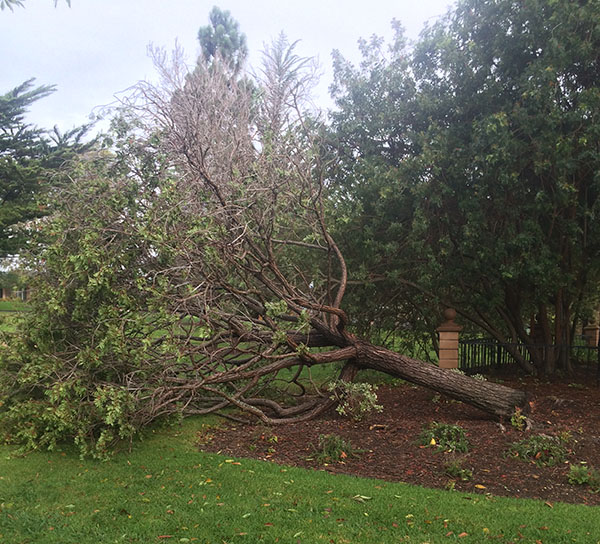On the Central Coast the past couple of weeks we have been fortunate enough to get some much needed rain. However, every year the first big storm is always the worst for trees. Our streets get littered with tree debris, trees fall on houses and cars, and all emergency crews for the city are scrambling to keep up with all the damage.

There are a lot of reasons that trees fall or fail. Some are that they are not healthy and others are very healthy. How do can you tell if a tree is at risk for failure? What can you do to protect your trees against storm damage?
The first reason people think trees fail is always that they think the tree was unhealthy. However, it is not the most common. Maybe it has trunk or root rot. Maybe a gopher ate all the roots. This is true for probably about half the trees. Root rot removes all the healthy roots making them prone to breaking. Trunk rot does the same thing but higher up in the tree. Root rot and trunk rot are most commonly identified by sapping and or fungal bodies (Mushrooms or conks). Usually by the time the mushrooms or conks appear on the tree it is too late to save it. If you catch the sapping early enough sometimes it is treatable with a fungicide or changing the growing conditions. Root rot is largely caused by the conditions the tree is growing in. For example, really wet areas, roots damaged by construction, or soil being piled up around the trunk.
The second reason trees fall is culture. There is a reason native plants grow where they do. It’s because they have been acclimated to that specific area through centuries of evolution. Planting trees that are not suited for their new climate or the space in your yard can affect the success of the tree greatly. Take for example Coast Redwood Trees. People think they are drought tolerant because they are native to California so they must be accustom to drought. Aren’t we in a drought? These trees are native to the coast line in northern California. They get constant moisture from the ocean and have a deep layer of acidic sandy soil that has built up for years. That is their ideal growing climate. People love them but don’t think about what they really need to be successful. They need Santa Cruz. They don’t like heavy clay soil, they need acidic soil, and most importantly they need water. That is why all the redwood trees throughout the county turn brown. It is also not from lack of sufficient water to grow the tree it is drought specifically. When the moisture content in the soil decreases the boron levels in the soil increase. Redwoods are sensitive to boron. This leads to failure by causing a tree to grow in an unhealthy environment.
The third and most common reason is weather damage. It’s not the rain and it’s not the wind. It is the both of them together. The rain increases the weight of the leaves and the branches. It also increases the volume of the material being blow through the air at the trees. The winds blows the heavily weighted trees. This is known as the “Sail effect”. There is more weight and surface area for the wind to catch. This is what causes the majority of storm damage. This can be avoided by caring for your trees properly. Pruning them for weight control, safety, and to reduce the “Sail Effect” with help reduce the possible damage to your trees in a storm.
Watch you trees. They are almost impossible to replace when they are big. Any storm or bad pruning can damage the tree for years. Take care of them from the beginning. They are a long term investment in your yard. “An ounce of prevention is worth a pound of cure”
Evan Moffitt,
ISA Certified Arborist
WE-8896
